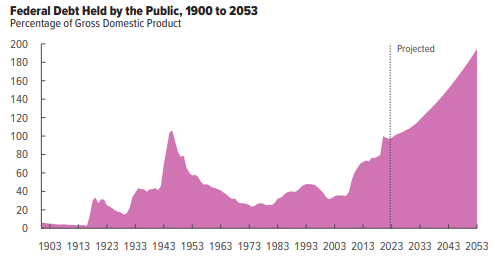Challenges in the Bond Market
Telemus Weekly Market Review November 6th - November 10th, 2023
Last year bond investors were impacted by rising short-term interest rates as the Federal Reserve began an aggressive rate hiking campaign. Thus far in 2023, bondholders have been affected by a rise in yields on bonds 5-years in maturity and longer. By some measures, overall interest rate volatility this year has exceeded the level of volatility of stocks.
After marching progressively higher in August through October, interest rates have gotten a bit of a reprieve over the last couple of weeks. However, this past Thursday yields on intermediate and longer dated maturities shot higher after a weak auction of 30-year U.S. Treasury bonds. In this case, the Treasury was issuing new 30-year bonds and to draw enough investor interest, the yield offered on the bond had to be increased in order to entice enough demand to satisfy the size of the auction. This event was noteworthy as it highlighted what has been rising investor concern on the ability of the federal government to finance its deficit without impacting interest rates.
The funding dynamic for the U.S. Treasury has evolved rather significantly since the early summer when Treasury markets faced the debt ceiling deadline. Since the debt ceiling resolution, the interest rate on the 10-year Treasury bond has risen by over a full percentage point. Having to issue bonds at this higher yield results in the Treasury locking in a higher level of interest rates on its newly issued debt. The byproduct of locking in present rates is higher government interest expense in the years to come.
To put interest costs in perspective, in 2019 the U.S. government spent $375 billion on interest expense to service its debt. Given the added fiscal spending associated with the pandemic, and rising rates that began in 2022, interest expense expanded to $659 billion in the federal government’s recently ended fiscal 2023i. Per the Congressional Budget Office (CBO), the Federal government is forecast to maintain and expand the size of its deficit over the next ten years. This will result in what the CBO projects to be $1.4 trillion of annual interest cost in 2033, more than double the current level.
Should the size of the U.S. deficit mirror projections by the CBO, concerns around the ability of markets to absorb the issuance of new Treasury bonds will persist. We take note at the potential imbalance between the projected supply of Treasuries and what demand might be. As the chart below highlights, given the projected deficits the amount of Treasury issuance is expected to accelerate. This comes at a time when the Federal Reserve has begun to shrink its balance sheet (and no longer buying more Treasuries), banks are electing to stay more liquid and not purchase longer-term bonds, and foreign investors are moving away from U.S. Treasuries. In the case of the later, the two largest international buyers of Treasuries (China and Japan) have begun to slow Treasury purchases. For China, a slowdown in exports to the U.S. has resulted in having fewer U.S. dollars to invest. For Japan, the appreciation of the U.S. dollar versus the yen and rising yields on Japanese Government Bonds have collectively led to U.S. Treasuries looking less attractive on a relative basis.

Source: Congressional Budget Office, The Budget and Economic Outlook: 2023 to 2033.
This growing concern around the ability to easily finance the federal borrowings has gotten the markets attention. Weeks such as this past week highlight that an event like a challenging auction can refocus attention on the challenges caused by the twin forces of elevated deficits and higher interest rates.
The debate and discussion around Federal borrowing costs is timely given the coincidence of a weak Treasury auction and this coming week’s budget deadline. These concerns led Moody’s, the only remaining debt rating agency to carry the U.S. government at the equivalent of a AAA rating, to lower its outlook on the United States. While Moody’s continues to rate the U.S. government at the highest bond rating, its action indicated that it is taking notice.
From an investor’s perspective, one must realize there are several factors influencing markets and thus the need to stay diversified and not be overly exposed to a single scenario. It’s likely that government funding dynamics, and others, will lead to greater volatility in the bond market over the intermediate term. However, a benefit of bond investing is the ability to lock in yields at the time of purchase and earn them over your holding period (assuming there are no bond defaults). By recognizing that bond prices will eventually revert, bondholders with a long-term horizon should feel comfortable wading through the volatility that exists in the bond market today.
iSource: U.S. Treasury, Congressional Budget Office
All opinions expressed in this article are for general informational purposes and constitute the judgment of the author(s) as of the date of the report. These opinions are subject to change without notice and are not intended to provide specific advice or recommendations for any individual or on any specific security. The material has been gathered from sources believed to be reliable, however Telemus Capital cannot guarantee the accuracy or completeness of such information, and certain information presented here may have been condensed or summarized from its original source. PAST PERFORMANCE IS NOT A GUARANTEE OF FUTURE RESULTS. Kovitz Investment Group Partners, LLC (“Kovitz”) DBA Telemus Capital. Telemus Capital is a division of Kovitz, a registered investment adviser with the Securities and Exchange Commission (SEC). Telemus Capital’s main office is located in Southfield, Michigan. SEC registration does not constitute an endorsement of the firm by the Commission nor does it indicate that the adviser has attained a particular level of skill or ability. Investment decisions should always be made based on the client's specific financial needs, goals and objectives, time horizon and risk tolerance. Current and future portfolio holdings are subject to risk. Risks may include interest-rate risk, market risk, inflation risk, deflation risk, currency risk, reinvestment risk, business risk, liquidity risk, financial risk, and cybersecurity risk. These risks are more fully described in Telemus Capital's Firm Brochure (Part 2A of Form ADV), which is available upon request. Telemus Capital does not guarantee the results of any investments. Investment, insurance, and annuity products are not FDIC insured, are not bank guaranteed, and may lose value. Any reference to an index is included for illustrative purposes only, as an index is not a security in which an investment can be made. Indices are unmanaged vehicles that serve as market indicators and do not account for the deduction of management fees and/or transaction costs generally associated with investable products. The S&P 500 index includes 500 leading companies in the US and is widely regarded as the best single gauge of large-cap US equities.
Advisory services are only offered to clients or prospective clients where Telemus Capital and its representatives are properly licensed or exempt from licensure. No advice may be rendered by Telemus Capital unless a client service agreement is in place.

Matt joined the Telemus team in 2018. As Chief Investment Officer, he leads the firms the investment process and research effort. Matt has experience as an equity analyst and portfolio manager and has advised corporate pension plans on their manager selection. He’s been quoted in Money Magazine and Barron’s.









